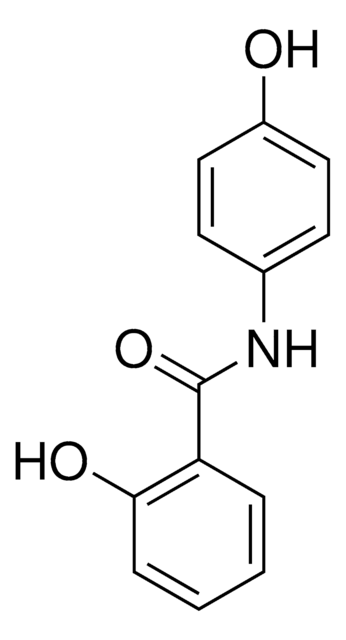70709
Hydroxyectoine
≥95% (HPLC)
Sinónimos:
THP(A)
Iniciar sesiónpara Ver la Fijación de precios por contrato y de la organización
About This Item
Fórmula empírica (notación de Hill):
C6H10N2O3
Número de CAS:
Peso molecular:
158.16
Número MDL:
Código UNSPSC:
24112111
ID de la sustancia en PubChem:
NACRES:
NA.21
Productos recomendados
Nivel de calidad
Ensayo
≥95% (HPLC)
Formulario
solid
cadena SMILES
CC1=N[C@@H]([C@@H](O)CN1)C(O)=O
InChI
1S/C6H10N2O3/c1-3-7-2-4(9)5(8-3)6(10)11/h4-5,9H,2H2,1H3,(H,7,8)(H,10,11)/t4-,5-/m0/s1
Clave InChI
KIIBBJKLKFTNQO-WHFBIAKZSA-N
¿Está buscando productos similares? Visita Guía de comparación de productos
Otras notas
Stabilizer for enzymes and biological macromolecules
Código de clase de almacenamiento
11 - Combustible Solids
Clase de riesgo para el agua (WGK)
WGK 1
Punto de inflamabilidad (°F)
Not applicable
Punto de inflamabilidad (°C)
Not applicable
Equipo de protección personal
dust mask type N95 (US), Eyeshields, Gloves
Elija entre una de las versiones más recientes:
¿Ya tiene este producto?
Encuentre la documentación para los productos que ha comprado recientemente en la Biblioteca de documentos.
S Cantera et al.
Bioresource technology, 267, 401-407 (2018-07-22)
This study constitutes the first-proof-of-concept of a methane biorefinery based on the multi-production of high profit margin substances (ectoine, hydroxyectoine, polyhydroxyalkanoates (PHAs) and exopolysaccharides (EPS)) using methane as the sole carbon and energy source. Two bubble column bioreactors were operated
Klaus Reuter et al.
PloS one, 5(5), e10647-e10647 (2010-05-26)
As a response to high osmolality, many microorganisms synthesize various types of compatible solutes. These organic osmolytes aid in offsetting the detrimental effects of low water activity on cell physiology. One of these compatible solutes is ectoine. A sub-group of
Annika C Mosier et al.
mBio, 4(2), e00484-e00412 (2013-03-14)
Microorganisms grow under a remarkable range of extreme conditions. Environmental transcriptomic and proteomic studies have highlighted metabolic pathways active in extremophilic communities. However, metabolites directly linked to their physiology are less well defined because metabolomics methods lag behind other omics
Wei-Chuan Chen et al.
Journal of bioscience and bioengineering, 128(3), 332-336 (2019-04-03)
Hydroxyectoine, an ectoine derivative, is the most common compatible solute in halophilic microorganisms for resisting harsh environments. Compatible solutes can be utilized in fields such as cosmetics, medicine, and biochemistry. Moderately halophilic microorganisms produce much less hydroxyectoine as compared with
Stanislav Obruca et al.
Applied microbiology and biotechnology, 100(3), 1365-1376 (2015-11-23)
Poly(3-hydroxybutyrate) (PHB) is a common carbon- and energy-storage compound simultaneously produced and degraded into its monomer 3-hydroxybutyrate (3HB) by numerous bacteria and Archae in a metabolic pathway called the PHB cycle. We investigated 3HB as a chemical chaperone capable of
Nuestro equipo de científicos tiene experiencia en todas las áreas de investigación: Ciencias de la vida, Ciencia de los materiales, Síntesis química, Cromatografía, Analítica y muchas otras.
Póngase en contacto con el Servicio técnico






